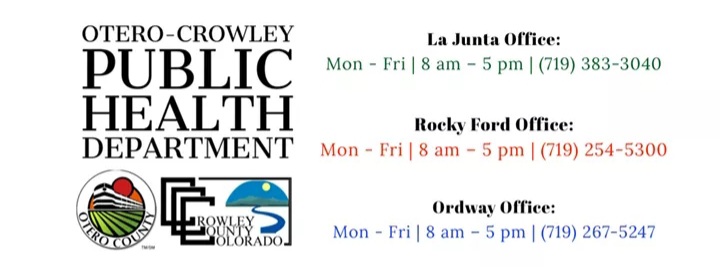Otero County Health Department Covid Update November 17th

Description: The Otero/Crowley County Health Department Covid-19 Update November 17th.

THIS IS A RAPIDLY EVOLVING AND FLUID SITUATION. INFORMATION AND ACTION ARE SUBJECT TO CHANGE AT ANY TIME. BE PREPARED TO BE FLEXIBLE AND PATIENT.
The situations, numbers, website links, data, and etc. described below were current as of Tuesday 11/17/2020 at 10:55am.
PLEASE DISTRIBUTE THIS WIDELY
11/17/2020 Crowley/Otero COVID-19 Update #1: What Do The Numbers Mean?
Please take the time to read and understand this entire message.
Internet links: Before I send out each update, I check the links to make sure they are active. However, links do change from time to time, so the links I sent out today may not be the same tomorrow. You may have to search around a bit.
Hello to all. Epidemiology is the study of the cause and control of diseases. It is actually made up of 2 Greek words: “Epi” which means “upon”, and “demos”, which means “people”. Demos is also part of the word democracy. So, in the Greek language epidemiology literally means “upon the people”. Quite appropriate, if you think about it, because communicable diseases do their nasty business ‘upon the people”. An integral tool of epidemiology is math, and more specifically statistics. We use statistics to help us figure out just how badly a disease is “upon the people”, and to decide on appropriate public health interventions (i.e. the color levels and their guidelines, restrictions) to slow the spread.
During this pandemic, we have seen a lot of numbers, particularly rates, and below will hopefully clarify how and why we use certain numbers and rates:
ü Two week cumulative incidence rate: Because population sizes in our state vary widely (like comparing Crowley County’s size to Denver County’s size), rates are often used instead of straight case counts to better compare the level of disease across different populations. How is this done mathematically? It is quite straightforward, actually. It is done by dividing the number of COVID-19 cases in a county by the population of that county, and then multiplying that number by 100,000. Regardless of the true population of any given county, an estimated comparison can be made across populations by using a baseline of 100,000 people. If you remember from last week’s update, I calculated Crowley County’s 2 week cumulative incidence rate to be 248.68, not including the prisoners that have tested positive for COVID-19. So, in essence, what is being said is “if Crowley County had a population of 100,000 people, the total number of cases during the last 2 weeks could be estimated at 248.68, or if you round up, 249. Just for fun (yes, math is FUN) let’s do the math:
o Calculation
§ Crowley County population: 6,031.88 (this is the number that the Colorado Department of Public Health and Environment (CDPHE) uses, so it’s what I use)
§ Actual number of cases from 10/28/2020 thru and including 11/10/2020 (14 days, 2 weeks), excluding COVID-19 positive prisoners within those 2 weeks: 15
§ Calculation: (15/6,031.88)*100,000 = 248.68. Do you remember the acronym PEMDAS from math class? Do what is in parentheses first (the “P”), then multiply by 100,000 (the “M”). The “E” stands for Exponents, but we did not have any so we ignore that. The other letters stand for Division, Addition, Subtraction. We did the division first because it was inside the parentheses.
§ So, in that 2 week period, Crowley County actually had 15 non-prisoner COVID-19 cases, but if Crowley County had a population of 100,000, that case count could be estimated at 248.68 cases.
o Comparing actual case numbers between counties with widely differing populations is like the old saying, “comparing apples to oranges”, or more like comparing apples to elephants. If we make the population the same size (i.e. 100,000) and adjust the count mathematically, then it is more like “comparing apples to apples.”
o Now, please go to this website: https://covid19.colorado.gov/
§ Click on Crowley County, and a new screen appears to the right, which says “Crowley County Two-Week Cumulative Incidence: 8,985”. This number is the rate per 100,000, and it DOES include COVID-19 positive prisoners.
o Rates are also very important to determine what color level a county is in. Again, please go to this website: https://covid19.colorado.gov/
§ Click on the “Show Level Determinants” link above the map, and a new screen will appear at the right. Look across the top row (New Cases), and you will see the rates/100,000 that determines the color levels.
§ IMPORTANT NOTE: Since prisoners are residents of what are called congregate care facilities, the COVID-19 positive prisoner numbers do not factor into the rate that determines a color level. The idea behind this is that the prisoners will not leave the facility, so they cannot directly spread the disease to members of the community. Prison staff, on the other hand, do leave the facility and, if they are found to be COVID-19 positive, they are counted in the numbers that determine the rate that determines the level.
ü Two week average positivity rate
o This is the average rate of positive cases over the past 2 weeks.
o How is it calculated: Within the last 2 weeks, this is the number of positive cases divided by the total number of tests that were done.
o Want to see this in action? Yet again, please go to the following website: https://covid19.colorado.gov/
§ Click on the “Show Level Determinants” link above the map, and a new screen will appear at the right. Look across the middle row (Percent Positivity), and you will see the percent positivity that determines the color levels.
That is the long story about numbers. The short story is that we need to get our numbers and rates down. Please, please, please do your part to stop the spread, it is up to us.
SECO News Encourages Only Sharing Public Health Information From Trusted Sources.
Follow SECO News on Facebook.
Subscribe to the SECO News YouTube Channel.
Press releases Sponsor

Healthcare Sponsor






.png)






.png)
.png)


.png)







